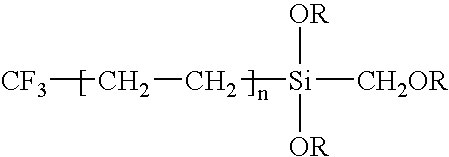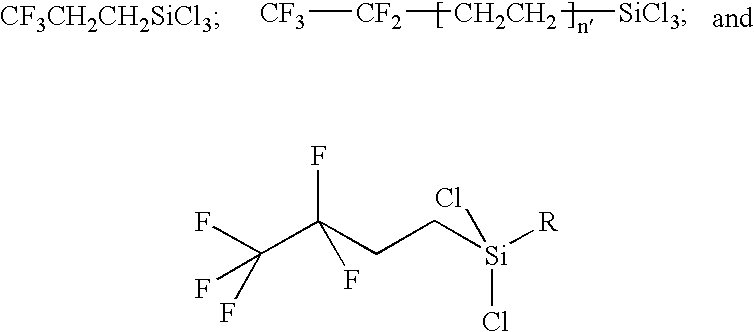Process for coating an optical article with an anti-fouling surface coating by vacuum evaporation
a vacuum evaporation and surface coating technology, applied in coatings, optical elements, instruments, etc., can solve the problems of inability to achieve low pressure in all vacuum chambers, and inability to achieve satisfactory anti-fouling top coat deposition, etc., to achieve good adhesion
- Summary
- Abstract
- Description
- Claims
- Application Information
AI Technical Summary
Benefits of technology
Problems solved by technology
Method used
Image
Examples
example 1
[0134] This experiment aims at evaluating the plasma power and treatment time required to treat an anti-fouling liquid coating material so as to successfully deposit an anti-fouling top coat onto the anti-abrasion coating of an already energetically treated ophthalmic lens.
[0135] The treatment with energetic species was a vacuum plasma treatment. The plasma used was a Plasma cleaners PDC-32G. A current of 1.2 A was used for evaporation (treatment time: 5 min).
[0136] The anti-fouling liquid coating material was an OPTOOL DSX coating solution, sold by DAIKIN Industries.
[0137] The contact angles were measured on finished optical articles according to the liquid drop method by having deposited a droplet of distilled water with a diameter smaller than 2 mm onto the coated surface of said optical article.
[0138] The lens as defined above was set in the vacuum chamber containing the evaporation device with no OPTOOL DSX deposited on the piece of steel wool. The chamber was closed and th...
examples 2-6
[0144] The treatment with energetic species was a vacuum plasma treatment, which allowed to simultaneously treating the outermost layer of the optical article and the liquid coating material. The plasma used was a Plasma cleaners PDC-32G with a plasma power of 18 W (720 V DC, 25 mA DC) and a treatment time of 20 seconds.
[0145] A current of 1.2 A was used for evaporation (treatment time: 5 min).
[0146] The liquid coating material was an OPTOOL DSX coating solution, sold by DAIKIN Industries or a KP 801M coating solution, commercialized by Shin-Etsu Chemical.
example 2
[0147] A lens with the abrasion-resistant coating as described above was set in the vacuum chamber containing the evaporation device with 1 mL of OPTOOL DSX deposited on the piece of steel wool. The chamber was closed and the vacuum was pulled (200 mTorr, ≈27 Pa). The plasma treatment started when the correct pressure was attained. The surface of the abrasion-resistant coating and the piece of steel wool, on which the OPTOOL DSX is deposited are simultaneously submitted to the plasma treatment. At the end of the treatment time (20 s after the start of the plasma in the chamber), the plasma power was turned off and the vacuum evaporation and deposition of OPTOOL DSX onto the surface of the abrasion-resistant coating was started by turning on the current for 5 minutes. The current was stopped and the vacuum was released.
PUM
| Property | Measurement | Unit |
|---|---|---|
| Thickness | aaaaa | aaaaa |
| Thickness | aaaaa | aaaaa |
| Pressure | aaaaa | aaaaa |
Abstract
Description
Claims
Application Information
 Login to View More
Login to View More - R&D
- Intellectual Property
- Life Sciences
- Materials
- Tech Scout
- Unparalleled Data Quality
- Higher Quality Content
- 60% Fewer Hallucinations
Browse by: Latest US Patents, China's latest patents, Technical Efficacy Thesaurus, Application Domain, Technology Topic, Popular Technical Reports.
© 2025 PatSnap. All rights reserved.Legal|Privacy policy|Modern Slavery Act Transparency Statement|Sitemap|About US| Contact US: help@patsnap.com



